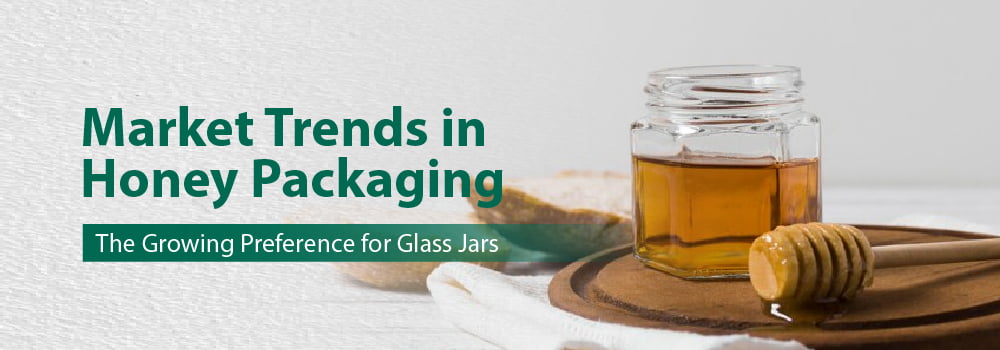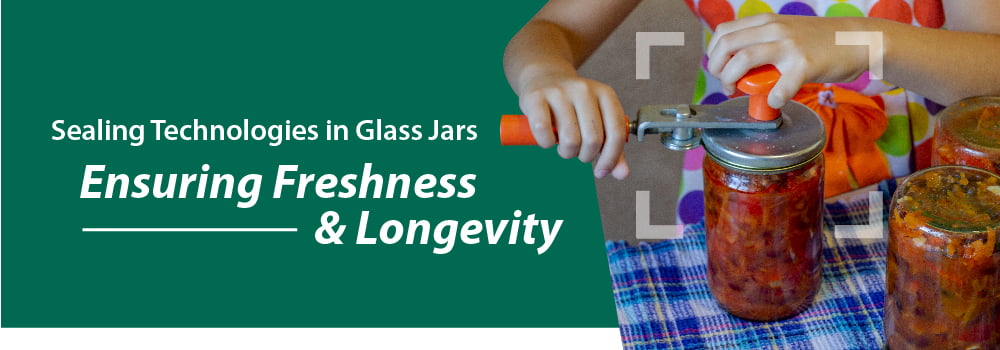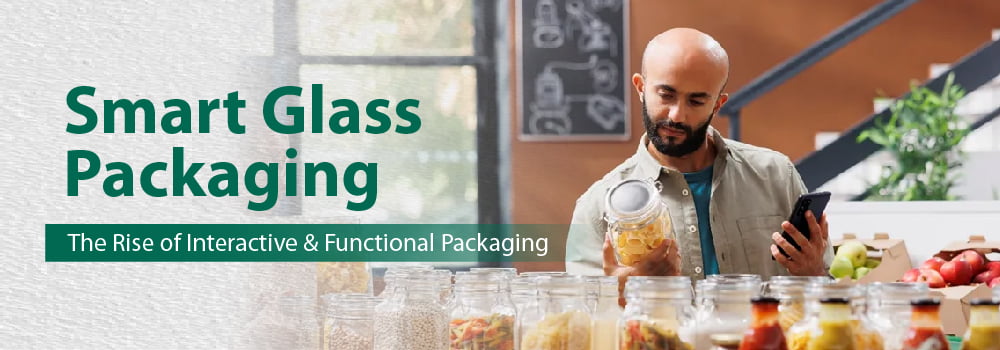Introduction: The honey market has experienced significant expansion in recent years, driven by the growing consumer demand for natural and organic products. Packaging, a key factor in the honey industry, not only preserves the product but also attracts and retains customers thanks to the customization it allows for.
A noticeable shift towards using glass jars for honey packaging has been observed. Today, let’s explore the latest trends in honey packaging. We will shed light on the market size, accelerators and opportunities, competitive landscape, packaging sizes, reasons behind the preference for glass packaging, and future market predictions.
Honey Market Size:
The global honey market is not just expanding, it’s booming, with the Indian market playing a significant role in this growth. According to recent data, the honey market size in India was valued at approximately USD 327 million in 2023 and is projected to reach USD 520 million by 2028, growing at a CAGR of 8.1%.
This robust growth stands testament to the increasing health consciousness among consumers and the rising popularity of honey as a natural sweetener. The future of the honey market is bright, with ample opportunities for growth and innovation.
Market Accelerators / Opportunities:
Several factors are driving the growth of the honey market.
Firstly, there is rising consumer awareness about the benefits of natural and organic products, with honey being a key player in this category. The health benefits associated with honey consumption, such as its antioxidant and antibacterial properties, further bolster its demand.
Additionally, there is an increasing appetite for premium and artisanal honey, often perceived as higher quality and more authentic.
The expansion of e-commerce has also impacted honey sales positively, making it easier for consumers to access a wider variety of honey products and packaging options.
Packaging Sizes:
Honey is commonly packaged in sizes such as 250g, 500g, and 1kg, catering to different consumer needs. S
Smaller sizes are popular for their convenience and affordability, making them ideal for occasional use or as gifts.
Larger packaging sizes, on the other hand, are favored by regular users and bulk buyers. T
The choice of packaging size significantly influences purchasing decisions, as consumers often weigh the cost per unit and the practicality of storage.
Why Glass Packaging is the Forerunner
Glass jars have become the preferred choice for honey packaging for several reasons:
- Aesthetic Appeal and Premium Look: Glass jars offer a sophisticated and upscale appearance that appeals to consumers seeking high-quality products. The transparency of glass allows the rich color and texture of honey to be showcased, enhancing its visual appeal.
- Preservation of Honey Quality and Flavor: Glass is an inert material that does not react with honey, ensuring the product’s purity and flavor are preserved. It also provides an excellent barrier against air and moisture, preventing spoilage.
- Eco-friendly and Sustainable Nature: Glass is 100% recyclable and reusable, aligning with the growing consumer preference for sustainable packaging solutions. The environmental benefits of glass packaging contribute to its popularity.
- Consumer Perception and Preference: The consumer’s perception of glass packaging is overwhelmingly positive. They often associate it with higher quality and better taste, a perception that brands using glass jars can capitalize on to differentiate themselves in the market. The glass transparency offers customers higher visibility of the color and texture of honey, instilling greater confidence in the product. This understanding of consumer preferences is crucial for brands looking to make an impact in the honey market.
In fact, honey brands extend customer engagement post-purchase. For instance, a small NGO, Bakri Chaap that adopts villages and supports the small industries there chose drinking mug jars for packing tier honey. The closers were changed, but the hope was that after the consumption of honey, the customer would continue to use the honey jar as a mug and thereby stay connected with the brand, enhancing brand recall and hopefully repeat business.
Future of the Honey Market:
The honey market and packaging industry are poised for continued innovation and growth. With an anticipated CAGR of 5.3%, the market is projected to expand from USD 449.8 million in 2024 to USD 626.8 million by 2033. In India, the honey market is segmented regionally into South India, North India, West India, and East India. In 2023, West India led the global market with a 41.1% share and is expected to maintain its dominance throughout the forecast period. The MultiFlora category currently leads the market, reflecting strong consumer preference for diverse and natural honey varieties.
Emerging trends in honey packaging include the development of smart packaging solutions and advanced glass technology that further enhance product preservation and consumer convenience.
Innovations such as tamper-evident seals, UV-protective coatings, and ergonomic designs are expected to become more prevalent.
Predictions indicate that the demand for glass packaging will continue to rise, driven by sustainability trends and consumer preferences.
However, the industry may face challenges such as cost pressures and the need for continuous innovation to meet evolving market demands.
These predictions provide valuable insights for industry professionals and stakeholders, helping them make informed decisions.
Market Segmentation and Trends:
The India Honey Market is segmented as follows:
By Processing:
- Conventional
- Organic
By Product Type:
- Alfalfa
- Acacia
- Wildflower
- Buckwheat
- Clover honey
- Others
By Application:
- Food & Beverages
- Personal Care
- Pharmaceutical
- Others
By Distribution Channel:
- Convenience Stores
- Online
- Hypermarkets & Supermarkets
- Others
By Flavour:
- Multiflora Honey
- Eucalyptus Honey
- Ajwain Honey
- Sidr Honey
- Others
Anticipated Growth in the Honey Packaging Industry:
The honey packaging industry is poised for substantial growth, driven by several key trends.
Firstly, the demand for premium and artisanal honey products is expected to increase, leading to greater adoption of high-quality packaging solutions such as glass jars.
Secondly, sustainability trends are pushing brands to adopt eco-friendly packaging materials, and 100% recyclable glass is a top contender in this regard.
Lastly, innovations in packaging technology, such as smart packaging and advanced glass treatments, are set to revolutionize the industry by enhancing product preservation, consumer convenience, and brand differentiation.
In conclusion, the honey packaging industry is undergoing significant transformation, with glass jars emerging as a preferred choice for many producers. This trend is driven by the material’s aesthetic appeal, superior preservation properties, and sustainability benefits. With the market continually growing and evolving, staying in tune with the trends will be crucial for honey producers. It’s not just about keeping up, it’s about being prepared and informed to capture consumer interest and maintain competitive advantage.
As the market evolves, the role of glass in honey packaging is expected to grow across the segments where it is used, offering brands opportunities to stand apart from the competition and meet consumer expectations for quality and sustainability.




